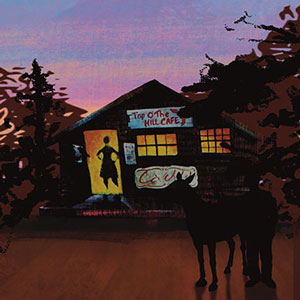
 *** “East Texas Hot Links” by Eugene Lee, tells a story from the summer of 1955 about the Top o’ the Hill Café, an African American establishment run by Charlesetta Simpkins (AnJi White). This is a place where friends and family come together and where stories are swapped, memories are shared, good-natured ribbing takes place, and the latest news is discussed. The café could be considered a place of refuge in this segregated community, where black people are impoverished and are “supposed to know their place.” Given that racial tensions are high, “It only takes a spark to light a stick of dynamite.” The show is named after one of the best-known styles of Texas sausage. According to the internet, “These Beaumont-style, all-beef sausages have a long tradition in the African American communities of east and south Texas.”
*** “East Texas Hot Links” by Eugene Lee, tells a story from the summer of 1955 about the Top o’ the Hill Café, an African American establishment run by Charlesetta Simpkins (AnJi White). This is a place where friends and family come together and where stories are swapped, memories are shared, good-natured ribbing takes place, and the latest news is discussed. The café could be considered a place of refuge in this segregated community, where black people are impoverished and are “supposed to know their place.” Given that racial tensions are high, “It only takes a spark to light a stick of dynamite.” The show is named after one of the best-known styles of Texas sausage. According to the internet, “These Beaumont-style, all-beef sausages have a long tradition in the African American communities of east and south Texas.”
The initial banter among the characters grounds the audience regarding race relations in this unnamed small town. Roy Moore (Kevin Roston, Jr.) talks about having fought in the war for his country. But was it ever really his country? Adolph, the professor (Willie B.), philosophizes about life and focuses on the social and redistributive needs of the community as a whole. His emphasis is at odds with that of XL Dancer (Juwan Lockett), who chooses to work on a major highway project, run by a white man named Ebert, who publicly wears his Ku Klux Klan robe. But XL pretty much argues that since this is the only gig in town, he is willing to work for a Klansman. The way XL sees things, he needs to earn decent money and have stable employment in order to be financially independent and get ahead in life. XL tells Delmus Green (David Dowd) that he wants to help him find a job. Should he work for Boss Man Ebert or not? The community definitely has a say about this. Other characters who frequent the café include Columbus Frye (Alfred H. Wilson), who is married to XL’s sister; Buckshot (Geno Walker); and Boochie Reed (A.C. Smith).
So much good-natured banter takes away from the fact that this show is actually about murder. A young black man was found in cement, and it was never clear whether this was an accident from working on the highway project or whether this was an intentional killing, presumably with underlying racial motives. It is only at the end of the first hour that we realize that discovering who the murderer might be is related to the main focus of the plot. Up until this point, we see this as largely a news item and as some fodder for speculation, since no one has any proof of what might have happened to the dead man or why—or who might have committed the crime (assuming that there was a crime in the first place).
My guest believed that this was indeed a murder (or perhaps a string of them) ultimately having its roots in miscegenation. I wasn’t so sure of this. Two men went missing and presumably killed after their illicit involvement with a woman, and yet I felt that there was enough ambiguity that anything could have happened. My reasoning is that all this is discussed in conversations, but we don’t actually witness the killings. That being said, white people in this town are bound to cover up any killings when it comes to the black community, making gossip and rumor possibly take over, and, with this, a rush to judgment.
In the play, Boochie is apparently a psychic of sorts, and he says that he sees a black cloud over one of the character’s heads. When seeing auras is suddenly on par with “normal rationality”, superstition obviously rules the day in this sleepy Southern town. So does this mean that Boochie is correct (and truly psychic) or that people in the community are simply anxious to find who the presumed murderer is and the root cause of their troubles, even if they have to make it up? To put this another way, is the character with the apparent black cloud over his head actually the murderer or the person setting up the murders (but not doing them)—or has he been enticed to become a murderer himself, because everybody is suddenly pitched against him?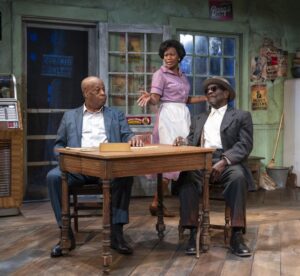
Thanks to the fine casting by Becca McCracken, all of the actors are convincing and work well together as a team. Moreover, the direction by Ron OJ Parson is great, especially with his excellent blocking (namely, the placement and movement of the actors to all parts of the stage and in relation to each other). Credit must also go to movement consultant Cristin Carole. The scenic design is extremely well done; the set is gorgeous. The pine trees are in the background in silhouette, and the roadside café interior is painted in 1950s “hospital green.” I loved the authentic prop design, with a jukebox and a pay telephone of that era, a countertop bar, wood tables, an old-fashioned refrigerator, and signs like that of Royal Crown Cola. Lighting, the province of Jason Lynch, is superior in this production. It starts out with red and orange lights that light up the trees behind the diner, in combination with the flat lighting of the interior. The exterior lights shift depending on time of day—and also as the story progresses; this is so cleverly and beautifully done! Special effects consultant and firearms coordinator Jim Guy has done a brilliant job bringing realism to the show, and the violence design is superb due to fight director Joe Foust’s impressive efforts!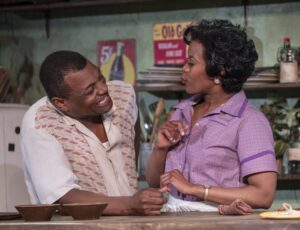
There is enough ambiguity in this story to make it interesting, especially when it comes to figuring out the characters’ motivations for action, and I’m not going to ruin the ending for you. The violence definitely puts all of us on the edge of our seats; and the dialogue, the emotion, and the incredible acting will make you want to see this play. Having said this, my guest felt that there are too many holes in the story, and we both felt that there are some confusing moments. And perhaps it is my failing that I didn’t catch some portion of the humor and some of the cultural references. Yet it is the superstitious aspect of the tale that let me down. I could not understand how the remaining characters could take Boochie’s mysticism seriously and view his observation as a fact without evidence. But then again, in a town where hard evidence suddenly disappears, what does one have left to go on?
“East Texas Hot Links” is playing through September 29, 2024, at the Court Theatre, 5535 S. Ellis Avenue, Chicago, on The University of Chicago campus.
Tickets are: $23.50 to $93.50.
Price includes per ticket fees.
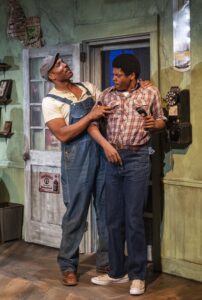 Performance schedule:
Performance schedule:
Wednesdays, Thursdays, and Fridays – 7:30 p.m.
Saturdays and Sundays – 2:00 p.m. and 7:30 p.m.
Accessible Performances:
September 28, 2024 at 2:00 p.m. (Touch Tour/Audio Description/ASL Interpretation)
Touch Tour at 12:30 p.m.
September 29, 2024 at 2:00 p.m. (Open Captioning
For more information and to purchase tickets, please visit: https://www.courttheatre.org/season-tickets/2024-2025-season/east-texas-hot-links/ or call the Box Office at (773) 753-4472.
Free parking is available next door to the theater.
To see what others are saying, visit www.theatreinchicago.com, go to Review Round-Up and click at “East Texas Hot Links”.


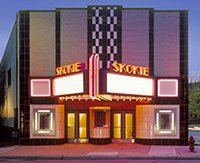



More Stories
“The Magic School Bus: Lost in the Solar System”
“February House” reviewed by Julia W. Rath
” A Lie of The Mind”